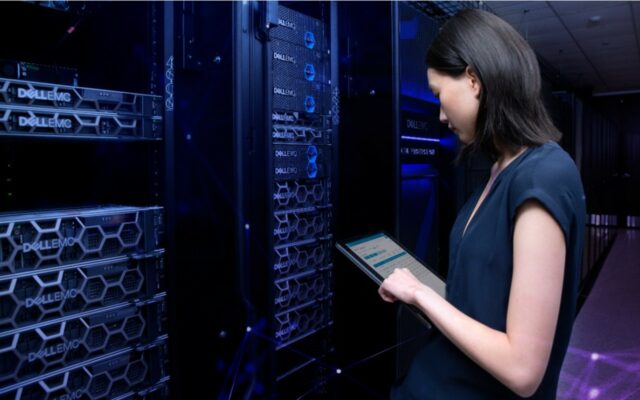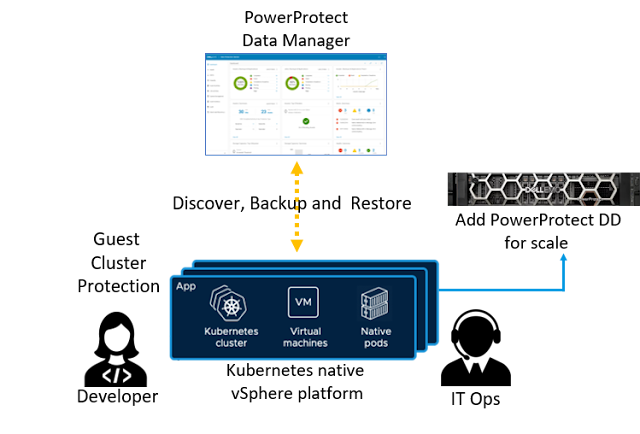January is the month for a fresh start. Especially after this past year, many of us resolved to reduce stress and simplify. If you’re like me and the millions of others who hope to make our lives easier in 2021, there is good news from Dell EMC PowerEdge and VMware. vSphere with Tanzu Basic is available through Dell Technologies, so you can easily and quickly get started with Kubernetes on PowerEdge servers. So, while VMware Tanzu may not be able to shovel your driveway, help your son with his virtual book report or tackle that pile of your laundry in your dining room, it CAN simplify your container management. And that’s a huge win right there.
Whether you’re brand new to containers or are looking for a way to simplify and secure the process, PowerEdge and VMware can help you quickly and more easily get started with Kubernetes and position you to future-proof your infrastructure.
Kubernetes = the Future of Modern Applications
Modern applications are increasingly built using containers. However, as these applications grow to span multiple containers, operating them gets more and more complex. This is where Kubernetes comes in. Kubernetes helps by managing clusters of virtual machines, grouping containers into pods, and scheduling containers to run based on available resources. It brings operations and software development together, simplifying the entire process.
Although containers have been around longer, Kubernetes is only about five years old (still a wee preschooler in tech years). But during that time the growth has been exponential — and there are no signs of slowing down. Consider:
◉ Gartner predicts that by 2025 more than 85% of global organizations will be running containerized applications in production – a significant increase from fewer than 35% in 2019.
and…
◉ By the same year more than 80% of independent software vendors (ISVs) will offer their application software in container format (up from less than 10% today).
Additionally, according to the VMware State of Kubernetes 2020 Report, Kubernetes use grew to 48% in 2020, up from 27% in 2018. Interestingly, the same report (which surveyed 247 individuals actively using Kubernetes) found that 60% of the time Kubernetes was deployed on-premises. Which means that organizations are taking advantage of existing infrastructure and established virtual environments to get started with Kubernetes.
For organizations still considering getting on the Kubernetes train, 2021 is the year many will jump on board.
Running Kubernetes Doesn’t Have to Be Complex
If you’re reading this, there’s a good chance your organization is already using, or at least considering using, containers — and you realize the need to support them. Wouldn’t it be great to embrace the newest technology and still manage the containerized applications using your existing tools? Fortunately, VMware Tanzu Basic enables you to do this securely, so you can quickly get started with Kubernetes.
VMware Tanzu Basic simplifies Kubernetes operation on-premises, uniting VMs and containers to offer a single application platform. It gives you everything you need to run Kubernetes using what you already know and love: vSphere.
vSphere 7 embeds Kubernetes in the vSphere control plane, which benefits both operators AND developers. Operators gain access to Kubernetes capabilities through a familiar set of tools and scripts, while developers can access cloud resources using Kubernetes APIs.
There’s no need to reinvent the wheel when you can use tools you’re already familiar with. Not only is this approach less daunting for anyone on the fence about using Kubernetes, but it’s more efficient and makes it easier to quickly get started. Which is important, considering enterprises are predicted to build over 500 million logical apps using cloud native tools and methods over the next five years (equal to the total number of apps built over the last 40 years!).
PowerEdge & VMware Partnership
To maximize performance, it’s no secret that great software runs best on great hardware. Together, PowerEdge and VMware combine best‑in‑class hardware and software to help you expand your modernization efforts. For over 20 years, we’ve worked closely to integrate our technology, solutions and support. With a focus on performance, scalability and security we work together to bring the best solutions to our joint customers.
Dell was one of the first to implement vSphere Lifecycle Manager (vLCM) when it was released as part of vSphere 7, bringing together firmware and software updates for simplified lifecycle management. When used with the OpenManage Integration for VMware vCenter (OMIVV) plug-in, you can simplify management in a familiar environment. Together, OMIVV and vLCM help organizations complete hypervisor and firmware updates in under 4 minutes (versus 3.5 hours manually) for an 8‑node PowerEdge cluster.
Additionally, we have the support you need. Dell has over 1,800 VMware-certified Dell Support professionals ready to help, so most hardware and software issues are resolved with a single phone call.
Dell offers Tanzu Basic OEM both as a standalone license as well as bundled together with vSphere 7 Enterprise Plus. To learn more about the benefits of running Tanzu on Dell EMC PowerEdge Servers, view this PowerEdge and vSphere with Tanzu infographic or visit our solutions page.
Source: delltechnologies.com



































